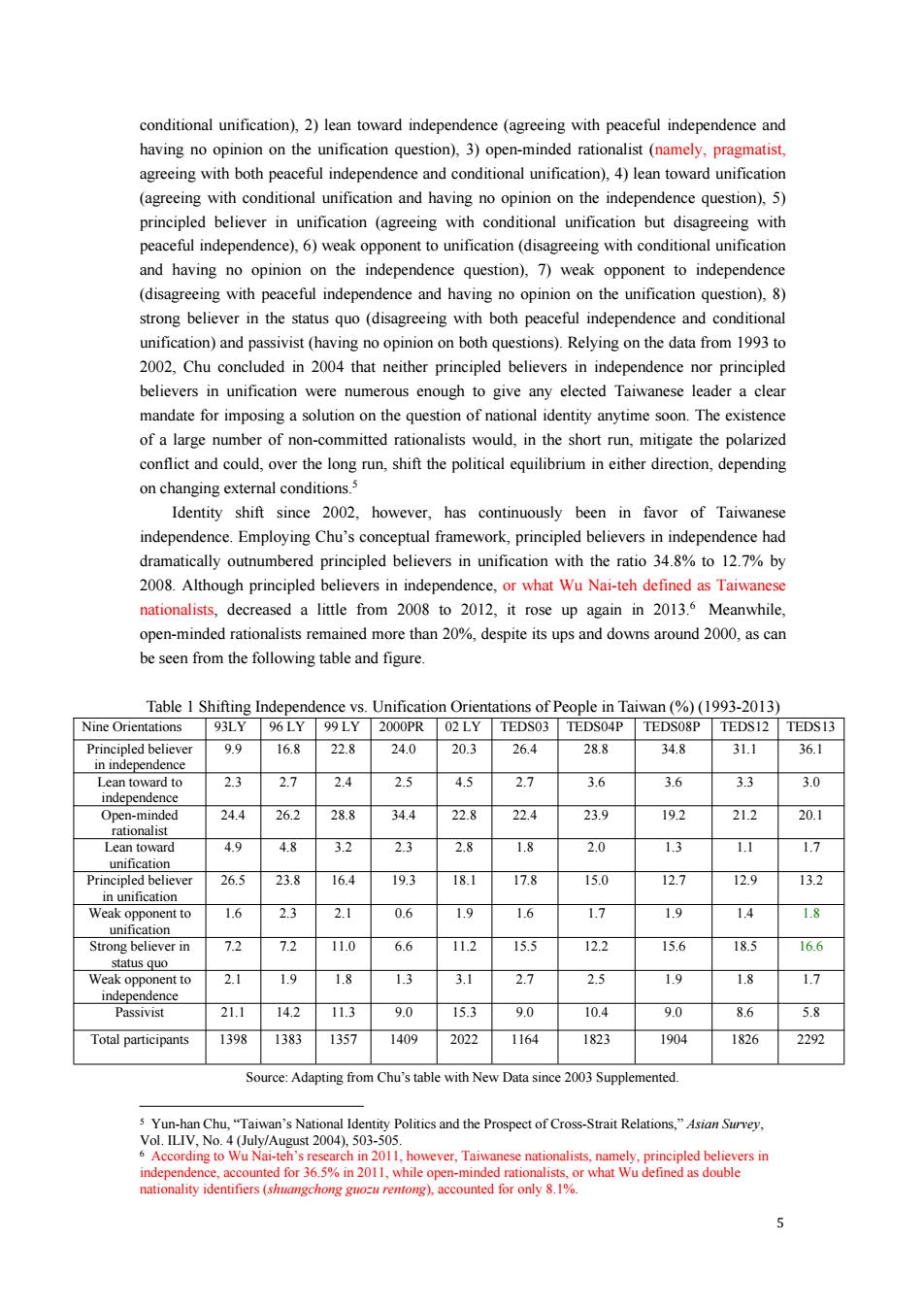正在加载图片...

conditional unification),2)lean toward independence (agreeing with peaceful independence and having no opinion on the unification question),3)open-minded rationalist (namely,pragmatist, agreeing with both peaceful independence and conditional unification),4)lean toward unification (agreeing with conditional unification and having no opinion on the independence question),5) principled believer in unification (agreeing with conditional unification but disagreeing with peaceful independence),6)weak opponent to unification(disagreeing with conditional unification and having no opinion on the independence question),7)weak opponent to independence (disagreeing with peaceful independence and having no opinion on the unification question),8) strong believer in the status quo(disagreeing with both peaceful independence and conditional unification)and passivist(having no opinion on both questions).Relying on the data from 1993 to 2002,Chu concluded in 2004 that neither principled believers in independence nor principled believers in unification were numerous enough to give any elected Taiwanese leader a clear mandate for imposing a solution on the question of national identity anytime soon.The existence of a large number of non-committed rationalists would,in the short run,mitigate the polarized conflict and could,over the long run,shift the political equilibrium in either direction,depending on changing external conditions.5 Identity shift since 2002,however,has continuously been in favor of Taiwanese independence.Employing Chu's conceptual framework,principled believers in independence had dramatically outnumbered principled believers in unification with the ratio 34.8%to 12.7%by 2008.Although principled believers in independence,or what Wu Nai-teh defined as Taiwanese nationalists,decreased a little from 2008 to 2012,it rose up again in 2013.6 Meanwhile, open-minded rationalists remained more than 20%,despite its ups and downs around 2000,as can be seen from the following table and figure. Table 1 Shifting Independence vs.Unification Orientations of People in Taiwan(%)(1993-2013) Nine Orientations 93LY 96 LY 99 LY 2000PR 02LY TEDS03 TEDS04P TEDS08P TEDS12 TEDS13 Principled believer 9.9 16.8 22.8 24.0 20.3 26.4 28.8 34.8 31.1 36.1 in independence Lean toward to 2.3 2.7 2.4 2.5 4.5 2.7 3.6 3.6 3.3 3.0 independence Open-minded 24.4 26.2 28.8 34.4 22.8 22.4 23.9 19.2 21.2 20.1 rationalist Lean toward 4.9 4.8 3.2 2.3 2.8 1.8 2.0 1.3 1.1 1.7 unification Principled believer 26.5 23.8 16.4 19.3 18.1 17.8 15.0 12.7 12.9 13.2 in unification Weak opponent to 1.6 2.3 2.1 0.6 1.9 1.6 1.7 1.9 1.4 1.8 unification Strong believer in 7.2 7.2 11.0 6.6 11.2 15.5 12.2 15.6 18.5 16.6 status quo Weak opponent to 2.1 1.9 1.8 1.3 3.1 2.7 2.5 1.9 1.8 1.7 independence Passivist 21.1 14.2 11.3 9.0 15.3 9.0 10.4 9.0 8.6 5.8 Total participants 1398 1383 1357 1409 2022 1164 1823 1904 1826 2292 Source:Adapting from Chu's table with New Data since 2003 Supplemented. s Yun-han Chu,Taiwan's National Identity Politics and the Prospect of Cross-Strait Relations,"Asian Survey, Vol.ILIV,No.4 (July/August 2004).503-505. 6According to Wu Nai-teh's research in 2011,however,Taiwanese nationalists,namely,principled believers in independence,accounted for 36.5%in 2011,while open-minded rationalists,or what Wu defined as double nationality identifiers (shuangchong guozu rentong),accounted for only 8.1%. 55 conditional unification), 2) lean toward independence (agreeing with peaceful independence and having no opinion on the unification question), 3) open-minded rationalist (namely, pragmatist, agreeing with both peaceful independence and conditional unification), 4) lean toward unification (agreeing with conditional unification and having no opinion on the independence question), 5) principled believer in unification (agreeing with conditional unification but disagreeing with peaceful independence), 6) weak opponent to unification (disagreeing with conditional unification and having no opinion on the independence question), 7) weak opponent to independence (disagreeing with peaceful independence and having no opinion on the unification question), 8) strong believer in the status quo (disagreeing with both peaceful independence and conditional unification) and passivist (having no opinion on both questions). Relying on the data from 1993 to 2002, Chu concluded in 2004 that neither principled believers in independence nor principled believers in unification were numerous enough to give any elected Taiwanese leader a clear mandate for imposing a solution on the question of national identity anytime soon. The existence of a large number of non-committed rationalists would, in the short run, mitigate the polarized conflict and could, over the long run, shift the political equilibrium in either direction, depending on changing external conditions.5 Identity shift since 2002, however, has continuously been in favor of Taiwanese independence. Employing Chu’s conceptual framework, principled believers in independence had dramatically outnumbered principled believers in unification with the ratio 34.8% to 12.7% by 2008. Although principled believers in independence, or what Wu Nai-teh defined as Taiwanese nationalists, decreased a little from 2008 to 2012, it rose up again in 2013.6 Meanwhile, open-minded rationalists remained more than 20%, despite its ups and downs around 2000, as can be seen from the following table and figure. Table 1 Shifting Independence vs. Unification Orientations of People in Taiwan (%) (1993-2013) Nine Orientations 93LY 96 LY 99 LY 2000PR 02 LY TEDS03 TEDS04P TEDS08P TEDS12 TEDS13 Principled believer in independence 9.9 16.8 22.8 24.0 20.3 26.4 28.8 34.8 31.1 36.1 Lean toward to independence 2.3 2.7 2.4 2.5 4.5 2.7 3.6 3.6 3.3 3.0 Open-minded rationalist 24.4 26.2 28.8 34.4 22.8 22.4 23.9 19.2 21.2 20.1 Lean toward unification 4.9 4.8 3.2 2.3 2.8 1.8 2.0 1.3 1.1 1.7 Principled believer in unification 26.5 23.8 16.4 19.3 18.1 17.8 15.0 12.7 12.9 13.2 Weak opponent to unification 1.6 2.3 2.1 0.6 1.9 1.6 1.7 1.9 1.4 1.8 Strong believer in status quo 7.2 7.2 11.0 6.6 11.2 15.5 12.2 15.6 18.5 16.6 Weak opponent to independence 2.1 1.9 1.8 1.3 3.1 2.7 2.5 1.9 1.8 1.7 Passivist 21.1 14.2 11.3 9.0 15.3 9.0 10.4 9.0 8.6 5.8 Total participants 1398 1383 1357 1409 2022 1164 1823 1904 1826 2292 Source: Adapting from Chu’s table with New Data since 2003 Supplemented. 5 Yun-han Chu, “Taiwan’s National Identity Politics and the Prospect of Cross-Strait Relations,” Asian Survey, Vol. ILIV, No. 4 (July/August 2004), 503-505. 6 According to Wu Nai-teh’s research in 2011, however, Taiwanese nationalists, namely, principled believers in independence, accounted for 36.5% in 2011, while open-minded rationalists, or what Wu defined as double nationality identifiers (shuangchong guozu rentong), accounted for only 8.1%